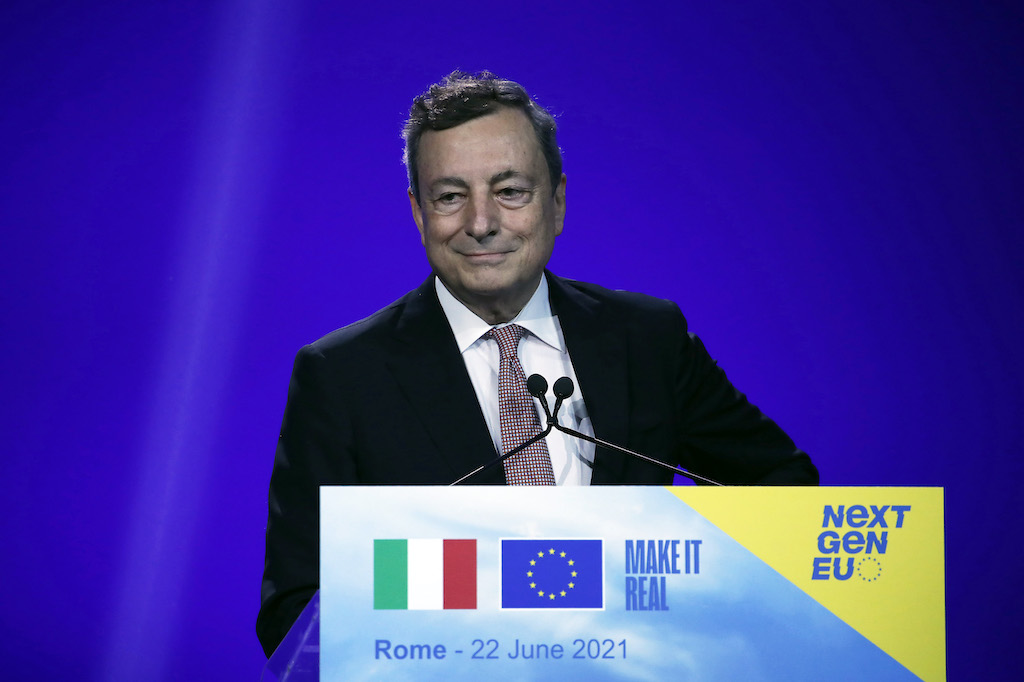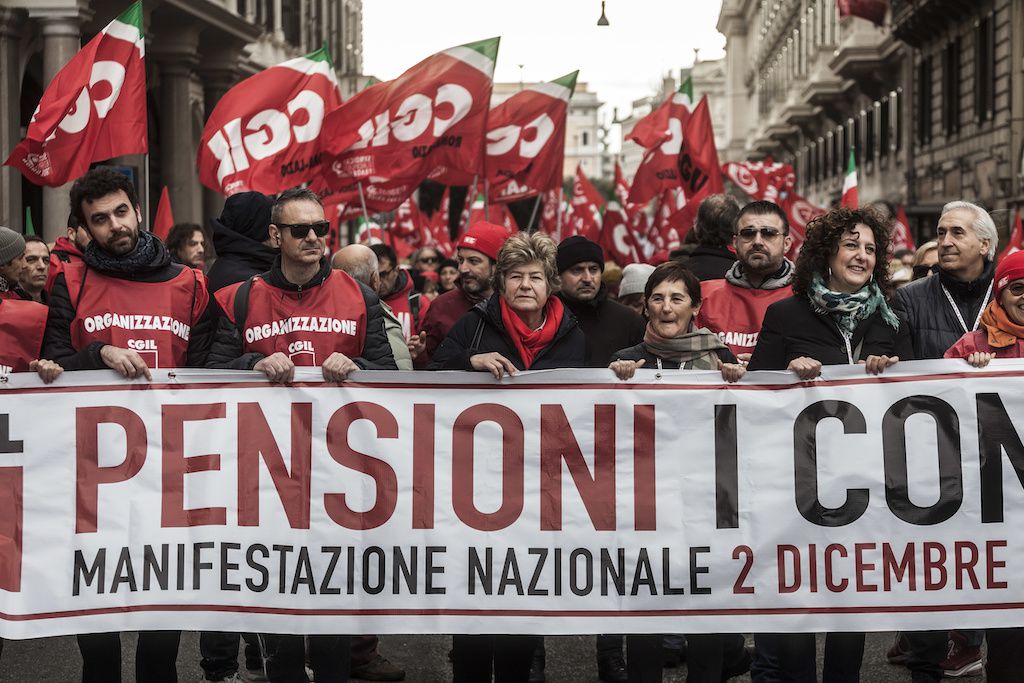Draghi leverages the EU Covid fund to push reforms
Former ECB head Mario Draghi has made some adroit moves as Italy’s prime minister. He also has the credibility in Brussels that his predecessors lacked. Can a Trojan horse strategy work in a country so resistant to change?

In a nutshell
- Mario Draghi’s job is making sure that Italy does not miss out on the opportunities provided by the EU Covid recovery funds
- The former central-banker-turned-politician skillfully keeps his caretaker government above the political fray
- Wielding the Brussel’s carrot, Prime Minister Draghi aims at limited reforms to make the country more business friendly
Italian Prime Minister Mario Draghi’s caretaker government took over in February 2021, following a showdown on the left. The former executive head Matteo Renzi (2014-2016) had unplugged the resolutely left-of-center government led by Giuseppe Conte (2019-2021). The main reason for contention was how Italy should spend its share of the so-called “NextGenerationEU” fund (the European Union’s massive fund to help all member states recover from the Covid crisis). Italy’s share in the fund is 191.5 billion euros, but Rome needed to come up with a spending plan acceptable to Brussels.
Indeed, Mr. Draghi appeared a more trustworthy player to European partners than Mr. Conte, a little-known law professor before his political debut two years ago. But the former head of the European Central Bank (ECB) also took upon himself the harrowing quest of enlisting virtually all political parties (except for Giorgia Meloni’s “Brothers of Italy”) in his program. Broad parliamentary coalitions almost inevitably lead to turbulence and conflicts. So far, Mr. Draghi has been remarkably skilled at shielding his government from such skirmishes. And they frequently occur, mainly since former moderate Prime Minister Enrico Letta (2013-2014) took over the Democratic Party and steered its rhetoric further to the left, echoing Bernie Sanders more than Joe Biden. So far, these fights are not weakening the government.
Things done right
In part, Mr. Draghi’s strength is attributable to the fact that all the parties want to take part in cutting the pie of European subsidies. However, the prime minister’s standing is also firmer than expected. This strength stems from two factors.
The prime minister took the NextGeneration milestone rather seriously.
The government has had a successful vaccination rollout: as of August 18, about 60 percent of the population was fully vaccinated; if those who got at least one jab were added, the figure totaled 86 percent. Such a fast rollout and high vaccinations level were hard to predict a few months ago. The success is credited to the new leadership of the vaccinations process provided by General Francesco Paolo Figliuolo, the Italian Army’s logistics head. Prime Minister Draghi appointed him to replace the less able Covid commissioner chosen by his predecessors.
A stronger-than-expected economic recovery has also boosted the government’s credibility. Italy’s growth projections for 2021 have been constantly revised upward, and now, gross domestic product expansion is expected to reach 5 percent. Of course, the country experienced an 11 percent GDP contraction last year, so this is a partial bounceback. Yet, it has proven more robust than expected. This performance is a shot in Mr. Draghi’s arm.
Draghi’s reform agenda
Of further importance is that the prime minister took the NextGeneration milestone rather seriously and his team has been working on reforms related to the EU’s subsidies and grants. Granted, the reform agenda does not comprise all the changes Italy needs – and the project will require many compromises to be clinched. Yet, Mr. Draghi has invested his precious political capital into it.
The government also promotes a justice system overhaul to speed up Italy’s notoriously slow criminal trials. The reform was unanimously approved by the cabinet, though the Five Star Movement is voicing dissent. The matter of contention is the statute of limitations. The Conte government, whose minister of justice was Five Star’s Alfonso Bonafede, froze the statute for appeal cases. The aim was to eliminate situations when criminals had to be freed because their cases dragged on for too long. In reality, the absence of time constraints for prosecution seemed to demoralize the Italian judiciary further. Many consider it as politicized and biased, particularly toward businesspeople and right-of-center politicians.
The bill will not be evolutionary but will set the stage for more open competition in some fields.
New Justice Minister Marta Cartabia, former president of the country’s Constitutional Court, did not abolish the Bonafede reform altogether but altered it. Her amendment sets time limits for the appellate courts and the Supreme Court of Cassation to rule once they take a case from a lower court. It is two years for the appeals courts and one year for the supreme court – but these terms can be extended (by a year for the appeals courts and six months for the supreme court) in particularly serious or complicated cases.

The reform epitomizes Draghi’s method and ambition. A wide left-to-right majority would hardly allow him to institute overly ambitious changes. However, using the carrot of European money and his personal prestige, the prime minister was able to convince the parties to swallow a bit more than they would have otherwise.
Next in line are the “annual competition law” and fiscal reform. The former is a strange corrective tool. The yearly commitment has been on the books since 2009. An annual omnibus bill is supposed to rectify the many ways in which parliament overruns good competitive practices in its regular legislative production. Yet a “competition bill” has been passed only once so far, in 2017. The Draghi staff is preparing a new text to be brought to parliament in September. The bill is expected to feature some initiatives to simplify the life of businesses in Italy. It will not be evolutionary but will set the stage for more open competition in some fields, like tenders in public procurement. The prime minister’s message is, you cannot entrust the future of a country to subsidies only.
The fiscal reform has more blurred contours. The Northern League has been campaigning for years for a flat tax while the Democrats and the Left want to raise tax rates for wealthier taxpayers. Minister of the Economy Daniele Franco, a former accountant general, has clarified that the reform should be accomplished at no net cost for the treasury. This suggests the government will ultimately end up with a reshuffling of the current tax system, lowering some taxes in order to raise some others. Yet Mr. Franco’s call to fiscal responsibility represents a welcome change after a year in which nearly universal consensus for more spending dominated the scene.
Vague elements
In the governance of the NextGenerationEU funds, reforms are milestones that are supposed to grant access to recovery funding. Italy’s spending plan has been much criticized by independent observers and think tanks.
More than 10 percent worth of the EU funds, 25 billion euros, will be spent to update the Italian railway network. This would include investments such as the high-speed train between Palermo and Catania, in Sicily, whose “sustainability” in terms of prospective customers is difficult to judge. The impression is that, since 70 percent of the investments ought to be planned and set firm by late 2022, the government needed to channel spending mainly through agencies known for their ability to spend the money they are entrusted with (never a given, with bureaucracies). Italy’s railways are one such agency.
The 200 billion euros from the EU is a lot of money, but Italy’s public spending is about 800 billion euros a year.
Most of the plan (37 percent of the investments) is to be devoted to the so-called “green transition.” This part is vague when it comes to specific projects. Despite the plan aiming to help the country recover from the pandemic, new spending for healthcare infrastructure is a smaller portion of the planned investments (15 billion euros). These projects are channeled through several initiatives, none of which promises to become a tipping point for better healthcare.
Trojan horse scenario
The Draghi government can justify itself by saying that its predecessors essentially prepared the plan, and that the new executive has worked at the margin, improving the existing project rather than developing a new one from scratch. However, if 200 billion euros sounds like an awful lot of money, it is well worth remembering that Italy’s public spending is about 800 billion euros a year. Basically, NextGenerationEU translates into an additional 5 percent for the next five years. This will not be enough to fix Italy’s problems.
Hence, Mr. Draghi’s strategy is to use it as a Trojan horse for limited but effective reforms to make the country more hospitable to business. This ambition implies a major rhetoric shift in the country’s politics, which could be, in itself, an accomplishment for the prime minister.
In 2018, the Northern League on the right and the Five Star Movement on the left won more than 50 percent of the Italians’ vote basically by denouncing reforms, particularly the pension reform accomplished by the government of Mario Monti in 2011, as a conspiracy on the part of the establishment to impoverish Italian families. This narrative implied a collective amnesty for the country, which was supposedly adequate as it was, whatever the level of its debt, whatever the structure of its public spending.
Italy needs reforms to sustain its staggering public debt; Covid spending made it skyrocket to 160 percent of GDP. Mr. Draghi is not a preacher for austerity, but he is reminding his country that money will not do much if you do not reform the dysfunctional government.







